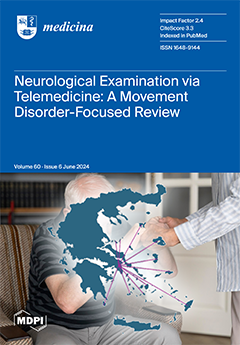Background and Objectives: Cervical radiculopathy (CR) manifests as pain and sensorimotor disturbances in the upper extremities, often resulting from nerve root compression due to intervertebral disc herniation, degenerative changes, or trauma. While conservative treatments are initially preferred, persistent or severe cases may
[...] Read more.
Background and Objectives: Cervical radiculopathy (CR) manifests as pain and sensorimotor disturbances in the upper extremities, often resulting from nerve root compression due to intervertebral disc herniation, degenerative changes, or trauma. While conservative treatments are initially preferred, persistent or severe cases may require surgical intervention. Ultrasound-guided selective nerve root block (SNRB) has emerged as a promising intervention for alleviating symptoms and potentially obviating the need for surgery. This study evaluates the therapeutic efficacy of ultrasound-guided SNRB in managing chronic CR, aiming to determine its potential in symptom relief and delaying or avoiding surgical procedures.
Materials and Methods: A retrospective analysis was conducted on 720 outpatients treated for CR between October 2019 and March 2022. After excluding patients with traumatic CR, previous surgeries, malignancies, progressive neurological symptoms requiring immediate surgery, or inadequate conservative treatment, 92 patients who had experienced cervical radicular pain for more than three months and had failed to improve after more than six weeks of conservative treatment with VAS scores ≥ 5 were included. The patients underwent single or multiple ultrasound-guided SNRB procedures, involving the injection of dexamethasone and lidocaine under real-time ultrasound guidance. Symptom severity was assessed at the baseline, and at 4, 8, and 12 weeks post-procedure using the Visual Analog Scale (VAS). The data collected included age, sex, presence of neck and/or radicular pain, physical examination findings, recurrence of symptoms, improvement in symptoms, and whether surgical intervention was ultimately required. Statistical analyses were performed to identify the factors associated with symptom improvement or recurrence.
Results: Significant symptom improvement was observed in 69 (75.0%) participants post-SNRB, with 55 (79.7%) showing improvement at 4 weeks, 11 (15.9%) at 8 weeks, and 3 (4.4%) at 12 weeks. Symptom recurrence, defined by an increase in VAS score accompanied by a pain flare lasting at least 24 h after a pain-free interval of at least one month, was noted in 48 (52.2%) patients. The presence of combined neck and radicular pain was a significant predictor of recurrence (
p = 0.008). No significant associations were found between symptom relief and factors such as age, gender, initial pain severity, or MRI findings.
Conclusions: Ultrasound-guided SNRB effectively manages chronic CR, providing substantial symptom relief and potentially reducing the need for surgical intervention. This technique offers a promising conservative treatment option, especially given its real-time visualization advantages and minimal radiation exposure.
Full article






